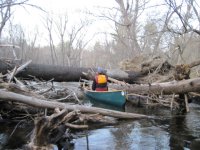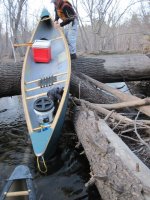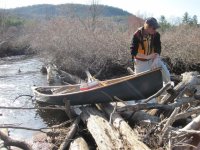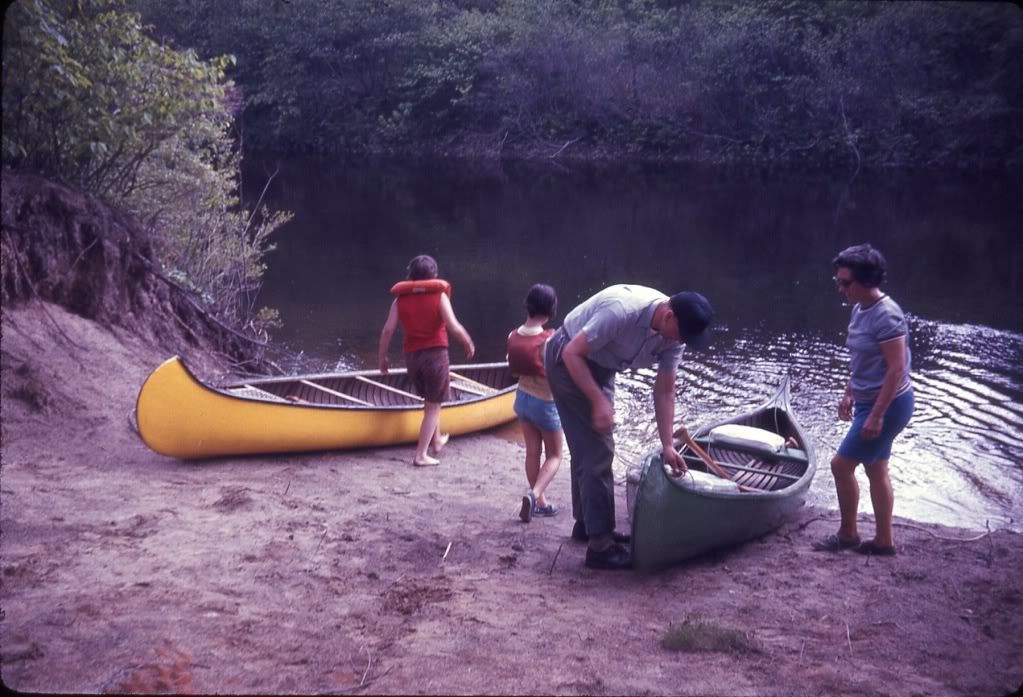A friend and I paddled a woodsy section of the Patuxent yesterday. Our rivers in Maryland are at summertime levels, and we knew we'd hit some blockages. We counted 13 "carries" and three sand-bars. Along the way, we had a discussion of what constitutes a "carry," and maybe that is the wrong word to use, for only two were true portage type carries were we picked the boat up and carried through the woods. We were just getting around strainers, not pond-hopping through the BWCA. The most frequent carry was just running the boat up on a downed tree that was spanning the river, stepping out onto the log, pulling the boat across, and hopping back in.
We disagreed on awarding half-carries. One log we almost made it entirely over. Steve, in the stern, needed only one foot on the log to push us the rest of the way over. Was that a carry or not a carry? Steve gave it a half-carry, but I have a hard enough time keeping count without getting into fractional carries. Steve wanted to give the next carry a 1.5. There were two river-wide logs about 30 feet apart. We climbed the 6' bank, pulled the boat up, and carried the boat through the woods past both logs, dropped the boat back in, and Tarzan-jumped into the boat. Given the difficulty of getting up and down the bank and bushwhacking the 80lb tripper past two strainers, Steve wanted credit for more than just one carry. That's trying to be a little too fine. All I want is a rough indicator to express how open or not open the river was, and I'll keep my count in whole units.
"Sand bars" were shallow sand or gravel areas we got through with one leg in the canoe and the other in the water, de-weighting and propelling the boat. Certainly, not a carry, yet another indicator of how open the stretch of water is at a given level.
I just wondered, does anybody else counts "carries"? (or perhaps I should call them "strainer events.")
Boats down there and we're up here. "Tarazan" re-entry required.
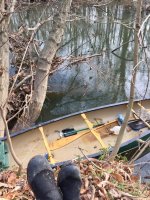
Most carries were off this variety. Run up on the log and pull over.
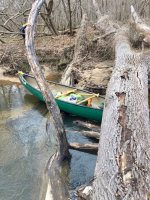
We disagreed on awarding half-carries. One log we almost made it entirely over. Steve, in the stern, needed only one foot on the log to push us the rest of the way over. Was that a carry or not a carry? Steve gave it a half-carry, but I have a hard enough time keeping count without getting into fractional carries. Steve wanted to give the next carry a 1.5. There were two river-wide logs about 30 feet apart. We climbed the 6' bank, pulled the boat up, and carried the boat through the woods past both logs, dropped the boat back in, and Tarzan-jumped into the boat. Given the difficulty of getting up and down the bank and bushwhacking the 80lb tripper past two strainers, Steve wanted credit for more than just one carry. That's trying to be a little too fine. All I want is a rough indicator to express how open or not open the river was, and I'll keep my count in whole units.
"Sand bars" were shallow sand or gravel areas we got through with one leg in the canoe and the other in the water, de-weighting and propelling the boat. Certainly, not a carry, yet another indicator of how open the stretch of water is at a given level.
I just wondered, does anybody else counts "carries"? (or perhaps I should call them "strainer events.")
Boats down there and we're up here. "Tarazan" re-entry required.

Most carries were off this variety. Run up on the log and pull over.



